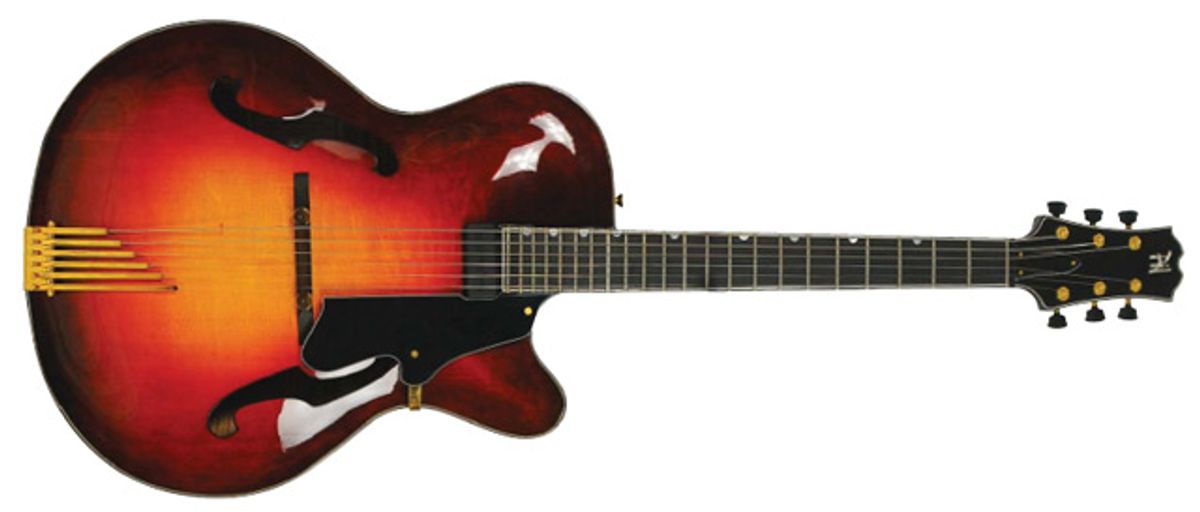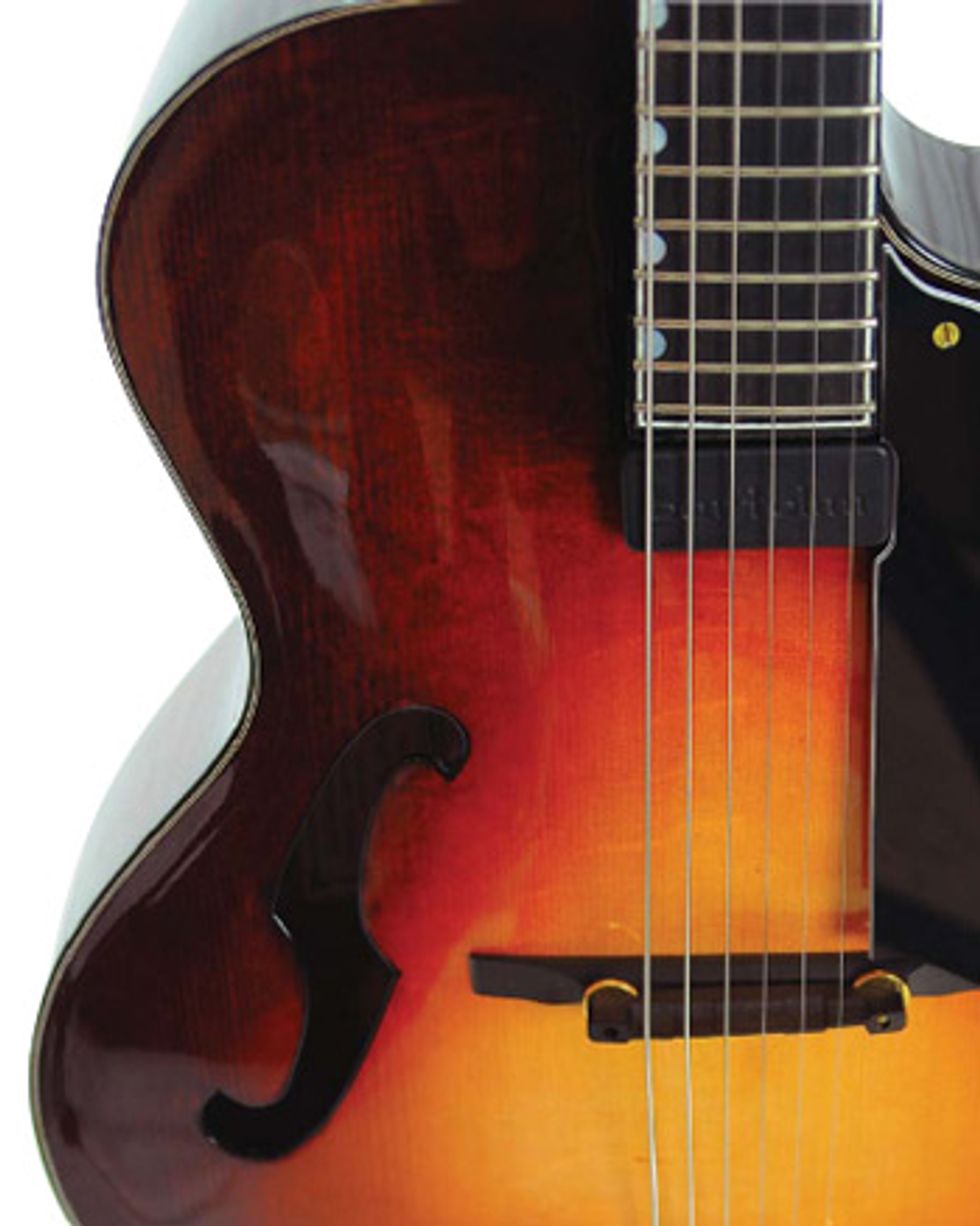
A high-end archtop from a one-man custom shop
| Download Example 1 DI - recorded straight from guitar using an Asterope cable |
|
| Download Example 2 Acoustic - recorded with a Rode NT1-A mic about a foot from the f-holes |
|
| Download Example 3 Amplified - recorded with a Vox AGA70 through the Tube-Pre channel (all amp tone stack settings at noon) with a Shure SM57. An Asterope cable was used from the guitar to the amp. |
Since opening his shop in 2006, Paul Hartmann has been creating both traditional archtops and solidbody electrics. Because he is a one-man shop, Hartmann doesn’t churn out many axes, which allows him to customize each one specifically for each customer. If you’re in the market for a one-of-a-kind instrument and aren’t worried too much about cost, the Dutchess might be right up your alley.
New York State of Mind
At first glance, the Dutchess—named after the county in New York where it is crafted— isn’t breaking any new ground when it comes to overall design, but really shows its unique side when you begin to look at the details. It sports American red flame maple back and sides, along with a bear claw American red spruce top, so you already know the guitar smells great. The lower bout measures a comfortable 17 ½”, and the top is braced using a single X method originally developed by Martin.
The three-piece maple neck has a mahogany center, for added support, along with a double-acting truss rod and Gretsch inspired fingernail-style fret markers. At 25”, the scale length feels just right, while the 12” fretboard radius makes the neck fast and smooth. Sliding up and down the neck, I noticed some of the edges of the fretwire were noticeably rough. To my hands, the fretboard feels a little wider than standard, which is great for fingerstylists, but might take some getting used to for flatpickers.
For electronics, there’s a floating Bartolini 5J pickup in the neck position and a very discreet volume control mounted on the pickguard. Hartmann took some inspiration from Gibson with the guitar’s adjustable 6-finger tailpiece, which looks similar to some late-model Howard Roberts Fusion III models. According to Hartmann, the individual fingers let you adjust each string’s intonation between the bridge and tailpiece.
Overall, the craftsmanship and design of the guitar was pretty solid. There weren’t any major flaws in the finish—which Hartmann outsources—and the guitar played well straight out of the box. For an instrument in this price range, I would expect nothing less.
Good Vibrations
The first thing I noticed when I opened the case—after the amazing flamed top—was that the guitar was set up with acoustic strings. Normally, even on acoustic/electric archtops, I tend to use electric strings, but when I began to strum the guitar, the acoustic strings really brought out the midrange frequencies and gave the tone some real projection, similar to a standard dreadnought. As I strummed full chords, the body vibrated with authority and provided good resonance and sustain.
When building this guitar, Hartmann’s benchmark for acoustic tone was his Brazilian rosewood Taylor 814ce. I didn’t have an 814ce handy, but I did compare it to a high-end Martin and the Dutchess made a respectable showing. Though the tone was a bit tighter than a dreadnought, the sound that leapt out of the f-holes was loud enough to cut through at a jam session.
 As I started to dig in with some Freddie
Green-approved chords, the guitar seemed
to really find its voice, and I could hear
some intriguing overtones depending on
how I held it. In photos of many old-school
jazz players, you can see they held the guitar
at an angle, with the back being free
and able to vibrate. By tilting the Dutchess
just slightly, the sound opened up and
seemed to breathe a lot more, perfect for
holding down the rhythm chair in a big
band. The tone became more focused with
some added presence when I held the guitar
more upright.
As I started to dig in with some Freddie
Green-approved chords, the guitar seemed
to really find its voice, and I could hear
some intriguing overtones depending on
how I held it. In photos of many old-school
jazz players, you can see they held the guitar
at an angle, with the back being free
and able to vibrate. By tilting the Dutchess
just slightly, the sound opened up and
seemed to breathe a lot more, perfect for
holding down the rhythm chair in a big
band. The tone became more focused with
some added presence when I held the guitar
more upright.I wanted to test the different possibilities with an archtop guitar, so I followed the luthier’s request by testing out some altered tunings on the Dutchess. Starting with open D tuning, the guitar was very responsive and bright. Although the action wasn’t set up for it, even some bottleneck slide guitar sounded pretty good. When I dug in, I could get close to some Delta-inspired mojo, but it didn’t quite make me want to replace my acoustic guitar.
As I explored the Dutchess acoustically, it seemed to shine with short chord stabs and single-note lines. The single notes had a real bite to them and sustained for days. In a solo or duo situation, such enhanced sustain can really help carry things along and make playing ballads a lot more fun.
Plugged In
I tested the Dutchess with two amps, a Vox AGA70 and a Goodsell Valpreaux 21. The Vox amp took the existing acoustic tone of the guitar and gave it a little more presence. The treble really came to life, and I discovered I needed to handle single-note lines and chord stabs a little more delicately when plugged in.
When I plugged into the all-tube Valpreaux, the guitar still held firmly onto its acoustic tendencies across all six strings. The Bartolini pickup was really clear and precise— something I look for in any kind of acoustic or archtop pickup—and was a nice compliment to the natural sound coming from the guitar. Considering the different types of room and amp combinations players encounter, I think an added tone control would give this guitar some versatility. The tone was close to a Jim Hall-esque sound—much like his trio recordings from the mid ’60s—but didn’t quite get there. More of the acoustic sound came through than I usually prefer, but that could be adjusted depending on the situation.
The Verdict
The Dutchess is a great sounding, well made archtop that would excel at either your solo coffeehouse gig or in a small combo setting. The rock-solid construction and interesting twists on the traditional archtop design makes the Dutchess a strong contender for players who aren’t concerned about price and want to invest in a pro-level axe.
Buy if...
you want a custom high-end archtop that has a strong acoustic side.
Skip if...
you need to cover a lot of musical bases during a gig and can only bring one axe.
Rating...
|
Street $6500 - Paul Hartmann Guitars - 845-229-9581
|
